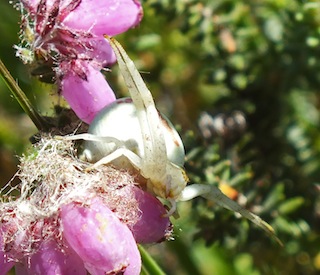 Look on flowerheads in the summer to see if you can spot a female Crab Spider – the camouflage is very good, so you’ll need to search carefully.
Look on flowerheads in the summer to see if you can spot a female Crab Spider – the camouflage is very good, so you’ll need to search carefully.
Photo: Amanda Scott
Scientific name: Misumena vatia
Other common names: Crab Spider
Cornish name: Kevnisen is the general word for spider
What to look for:
- Colouring: Females vary between white, green and yellow, changing their colour to blend with the background, and often (but not always) have two red spots (sometimes merged into lines) on their abdomen; males are pale green to white with brown stripes on their abdomens.
- Size: Females – 9 to 11 mm; males – 3 to 4 mm.
- Where: Across Europe and North America; in Britain it is mainly restricted to the south of England and Wales. Look on flowerheads in woodland rides and edges, grass or scrub, or even in gardens.
- When: Mainly found between May and July.
 When we imagine a predator ambush, it is lions or other large carnivores, hiding in the long grass ready to leap out and chase down their prey, that come to mind. However, many much smaller creatures also use ambush: the Crab Spider is one of these. It doesn’t spin a web, but instead sits very still, often on a white or yellow flowerhead, holding out its elongated front pair of legs, waiting for its prey to wander near – and then it pounces and bites, injecting venom. The unsuspecting creature is further fooled by the female spider’s ability to change colour to camouflage itself against its background (males lack this ability).
When we imagine a predator ambush, it is lions or other large carnivores, hiding in the long grass ready to leap out and chase down their prey, that come to mind. However, many much smaller creatures also use ambush: the Crab Spider is one of these. It doesn’t spin a web, but instead sits very still, often on a white or yellow flowerhead, holding out its elongated front pair of legs, waiting for its prey to wander near – and then it pounces and bites, injecting venom. The unsuspecting creature is further fooled by the female spider’s ability to change colour to camouflage itself against its background (males lack this ability).
Females and the much smaller males mate in the early part of the summer, following which the female lays her eggs and disguises them amongst leaves, secured with silk. Once the young spiders emerge they overwinter in the leaf litter and undergrowth, before emerging and maturing the next year.
Did you know…?
…The Crab Spider eats its prey by making tiny holes in its body and then sucking out the insides, leaving the exoskeleton behind once it has finished.
…The female’s colour-changing, particularly effective on white and yellow flowers, isn’t anything like as swift as its pounce – it takes about two days.
Published: July 2014
Author: Amanda Scott
Photo: Amanda Scott
